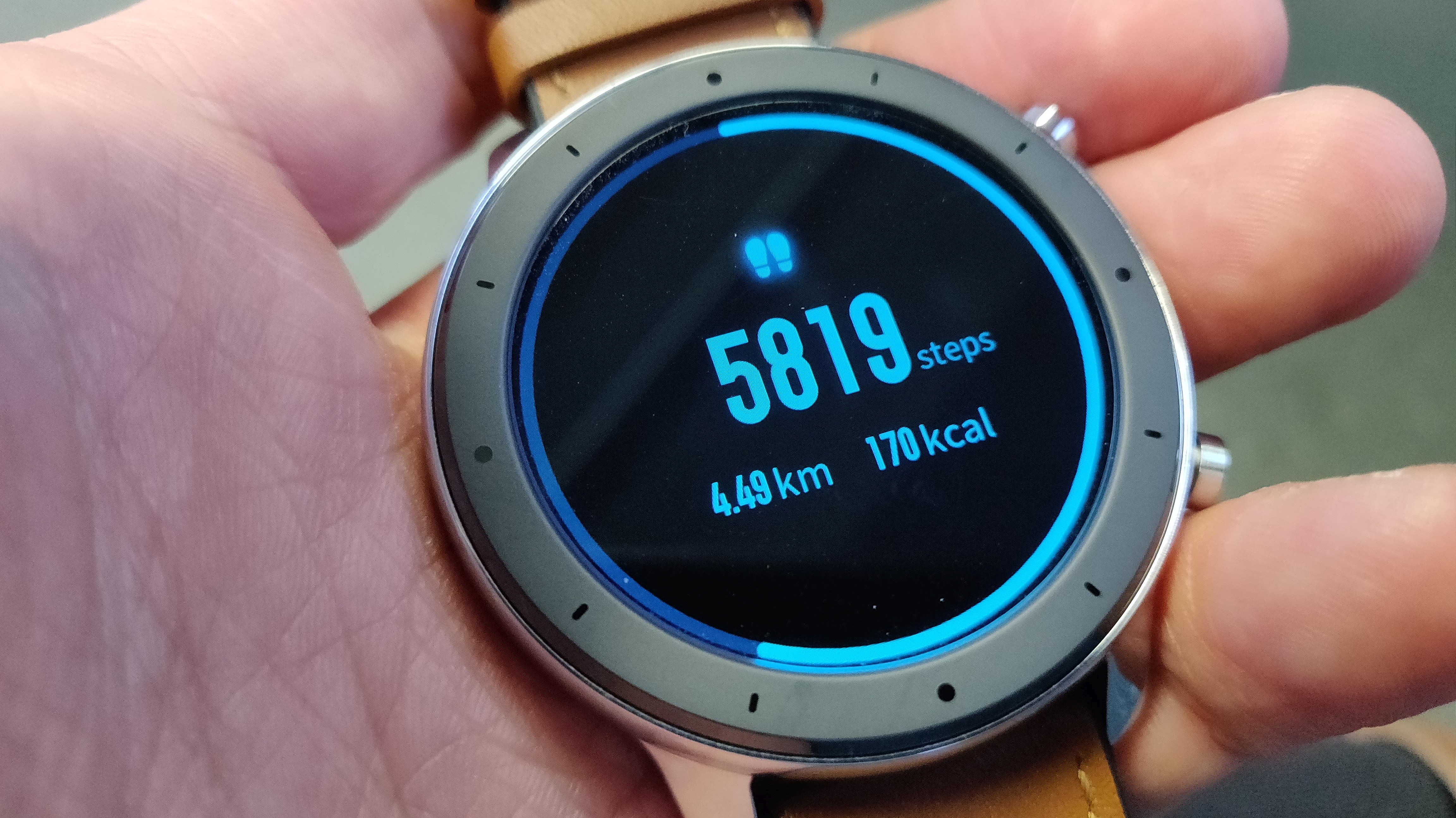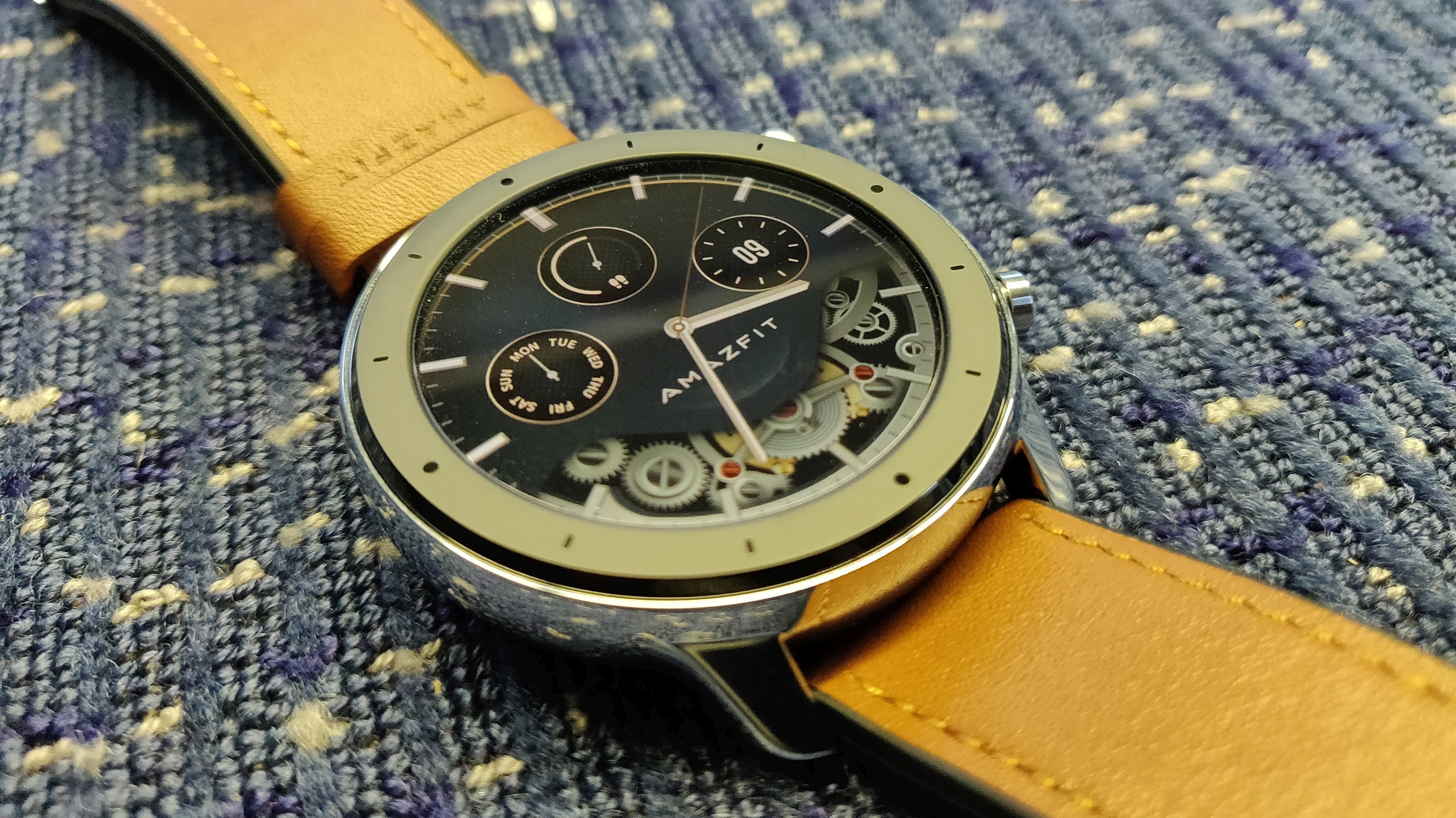Why you can trust TechRadar
Performance
- Limited app integration
- Sluggish swiping between screens
- In-depth heart rate statistics
- Accurate GPS for run/walk tracking
At this price point, you wouldn’t expect any fancy app integrations, especially as the Amazfit GTR runs proprietary software, rather than Wear OS, and indeed it offers few surprises.
You can flick between tracks if you’re playing music on your phone (although you can’t store music on the device), and the few built-in Amazfit apps - such as weather, heart rate tracking, and ‘find my phone’ - are easy to navigate on your wrist. But generally, you use the GTR for checking app notifications, and not much more.
It’s a shame, then, that those notifications feel like afterthoughts. When they pop up, they look off-center, and use an awkward font. They display little detail: you can’t see the body of emails, for example, only the subject line.
Emojis from WhatsApp messages won’t show up, which is annoying, and there’s no option to act on notifications, such as replying to a message. Essentially, it feels as basic as it could possibly feel. It's a reminder to look at your phone, and not much more.
We like that notifications are off by default and that you need to enable apps individually, which keeps distractions to a minimum. But when alerting you to notifications is the thing you’ll use the GTR for most often, it’s disappointing that it feels so spartan.

But the low price comes at a cost to performance. Swiping between watch faces feels sluggish. Sometimes, the watch has a delayed response to your touch; other times, it simply chugs between the various screens.
Occasionally, it failed to register our swipes completely, particularly when we were swiping down on the watch face to access settings or a do not disturb mode. However, turning our wrist to wake the screen up worked reliably, and we were always able to see the time at a glance.
Sign up for breaking news, reviews, opinion, top tech deals, and more.
We also like that you can program one of its side buttons to perform a number of functions, such as to show your heart rate, the weather, or a compass. We set it to launch an activity, which was handy for starting runs or walks.
Fitness and tracking
- Accurate step tracking, GPS and heart rate
- PAI score isn't reliably tracked
- App is fiddly but includes a lot of stats
The Amazfit GTR fares better when it’s tracking your activity than when it’s displaying notifications. Step count was accurate - when we walked 100 steps it always got within five - and heart rate was largely correct, when compared to our manual tests over the course of a minute.
We were also impressed by the level of detail within the Amazfit app: on your step count page it will tell you how far you traveled, how many calories you burned, and estimates of your activity history, including whether you were walking fast or slow.

You can tell the watch to track your heart rate constantly, which measures it every minute while still getting strong battery life (see below). We enjoyed looking back on our heart rate at the end of the day, and during 30-minute runs we could see when our pulse quickened as we ran faster.
If you don’t want to track heart rate all the time, then you can set it to track sporadically to save battery, and then ask it to detect when you start an activity, at which point it will track your pulse constantly. This was hit and miss: once, tracking kicked in immediately when we started running, but the next time it took a good 90 seconds to catch up.
The GTR will automatically tell you your Personal Activity Intelligence score - a popular measure of activity backed by a fair bit of science - for the week, calculated based on your heart rate. The idea is that reliably getting the score over 100 each week decreases your risk of health issues, such as heart disease.
It has limited success, here. Having a specific score to aim at gave us plenty of motivation to exercise, but we felt like the score wasn’t racking up when it should have been.
A single run would increase our score by 30, but PAI is also meant to take into account lower-level activity such as walking. A heavy weight session when our heart was pumping didn’t make a dent in the score, unfortunately.

Sleep tracking was... well, it’s sleep tracking on a smartwatch, with all the limitations that comes with that. The Amazfit GTR will track when you fall asleep, when you wake up, and when you’re in deep sleep.
The deep sleep proportion is impossible to verify - smartwatches in general aren’t a good tool for this - but the time slept was, we found, broadly accurate.
It sometimes thought we’d fallen asleep earlier than we actually did, probably because we were just lying still, and it failed to detect us waking up in the middle of the night. But for comparing how long you’re sleeping night-to-night, it’s perfectly fine, and it will tell you how you measure up against other users.
Where the GTR impressed us most was when it was tracking outdoor runs or walks with the built-in GPS, which works independently of your phone.
The GPS occasionally took a while to get a position lock, sometimes two minutes or more, but when it found us, it remained accurate: when we synced with the Amazfit phone app post-run, it traced the line of our route without any noticeable mistakes. The same was true for walks.
The Amazfit app itself can be a bit fiddly, and it’s not immediately obvious where you go to view your tracked activities. However, when you do find a run or walk, it gives you plenty of detail, including time splits by kilometer, average and max heart rate, altitude changes, and how long you paused the activity for.
It was far more than we’d expect from a smartwatch this cheap, and means that we can happily use this as our main activity tracker while out running (albeit with our phone in tow, to listen to music).
That said, remember, this is still a budget smartwatch. It has 12 exercise options to track including swimming, and should be water resistant up to 50m (we only tested it in a sink, where it held up fine). It won’t track more complex motions, like reps in a weight-lifting session. Most gym activities are just grouped broadly under the ‘exercise’ heading, which isn’t all that useful - you can manually tag them later if you want to go to that effort, though.

Battery life
- 42mm not as impressive as Huami’s estimates, but you’ll still only be charging once a week
- 47mm drains around 5% a day, which is incredible for a watch this affordable
- GPS doesn’t cause too big a strain
Huami reckons you’ll get 12 days out of the 42mm watch under normal usage, but we fell far short of that. Its estimate is based on constant heart rate detection, sleep monitoring and three, 30-minute GPS exercise sessions a week, which is essentially the setup we had. But after seven days, we were down to the dregs.
It’s therefore less impressive than the company would have you believe. However, we don’t think it’s a big issue, as a week on a single charge is still impressive, stretching longer than almost anything on our list of best cheap smartwatches including pricier wearables than the GTR. Going a week on a single charge for any smart device is, to us, a win.
The 47mm is even better: its bigger body can fit a 410mAh battery, compared to the 195mAh battery in the 42mm version. That size makes a huge difference - we didn’t have time to run it down to zero from full charge, but it was using around 5% per day without GPS, with up to 10% on days with GPS.
Extrapolating, you’re probably looking at 15-20 days of battery life on a full charge. That’s not quite the 24 days of normal usage Huami claims, but it’s still more than enough.
Current page: Performance, fitness and battery life
Prev Page Introduction, design and display Next Page Verdict and competition